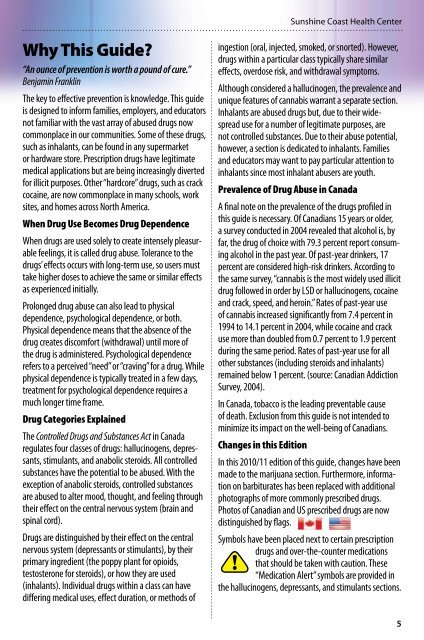Drugs Of Abuse - Sunshine Coast Health Centre
Drugs Of Abuse - Sunshine Coast Health Centre
Drugs Of Abuse - Sunshine Coast Health Centre
You also want an ePaper? Increase the reach of your titles
YUMPU automatically turns print PDFs into web optimized ePapers that Google loves.
Why This Guide?<br />
“An ounce of prevention is worth a pound of cure.”<br />
Benjamin Franklin<br />
The key to eff ective prevention is knowledge. This guide<br />
is designed to inform families, employers, and educators<br />
not familiar with the vast array of abused drugs now<br />
commonplace in our communities. Some of these drugs,<br />
such as inhalants, can be found in any supermarket<br />
or hardware store. Prescription drugs have legitimate<br />
medical applications but are being increasingly diverted<br />
for illicit purposes. Other “hardcore” drugs, such as crack<br />
cocaine, are now commonplace in many schools, work<br />
sites, and homes across North America.<br />
When Drug Use Becomes Drug Dependence<br />
When drugs are used solely to create intensely pleasurable<br />
feelings, it is called drug abuse. Tolerance to the<br />
drugs’ eff ects occurs with long-term use, so users must<br />
take higher doses to achieve the same or similar eff ects<br />
as experienced initially.<br />
Prolonged drug abuse can also lead to physical<br />
dependence, psychological dependence, or both.<br />
Physical dependence means that the absence of the<br />
drug creates discomfort (withdrawal) until more of<br />
the drug is administered. Psychological dependence<br />
refers to a perceived “need” or “craving” for a drug. While<br />
physical dependence is typically treated in a few days,<br />
treatment for psychological dependence requires a<br />
much longer time frame.<br />
Drug Categories Explained<br />
The Controlled <strong>Drugs</strong> and Substances Act in Canada<br />
regulates four classes of drugs: hallucinogens, depressants,<br />
stimulants, and anabolic steroids. All controlled<br />
substances have the potential to be abused. With the<br />
exception of anabolic steroids, controlled substances<br />
are abused to alter mood, thought, and feeling through<br />
their eff ect on the central nervous system (brain and<br />
spinal cord).<br />
<strong>Drugs</strong> are distinguished by their eff ect on the central<br />
nervous system (depressants or stimulants), by their<br />
primary ingredient (the poppy plant for opioids,<br />
testosterone for steroids), or how they are used<br />
(inhalants). Individual drugs within a class can have<br />
diff ering medical uses, eff ect duration, or methods of<br />
<strong>Sunshine</strong> <strong>Coast</strong> <strong>Health</strong> Center<br />
ingestion (oral, injected, smoked, or snorted). However,<br />
drugs within a particular class typically share similar<br />
eff ects, overdose risk, and withdrawal symptoms.<br />
Although considered a hallucinogen, the prevalence and<br />
unique features of cannabis warrant a separate section.<br />
Inhalants are abused drugs but, due to their widespread<br />
use for a number of legitimate purposes, are<br />
not controlled substances. Due to their abuse potential,<br />
however, a section is dedicated to inhalants. Families<br />
and educators may want to pay particular attention to<br />
inhalants since most inhalant abusers are youth.<br />
Prevalence of Drug <strong>Abuse</strong> in Canada<br />
A fi nal note on the prevalence of the drugs profi led in<br />
this guide is necessary. <strong>Of</strong> Canadians 15 years or older,<br />
a survey conducted in 2004 revealed that alcohol is, by<br />
far, the drug of choice with 79.3 percent report consuming<br />
alcohol in the past year. <strong>Of</strong> past-year drinkers, 17<br />
percent are considered high-risk drinkers. According to<br />
the same survey, “cannabis is the most widely used illicit<br />
drug followed in order by LSD or hallucinogens, cocaine<br />
and crack, speed, and heroin.” Rates of past-year use<br />
of cannabis increased signifi cantly from 7.4 percent in<br />
1994 to 14.1 percent in 2004, while cocaine and crack<br />
use more than doubled from 0.7 percent to 1.9 percent<br />
during the same period. Rates of past-year use for all<br />
other substances (including steroids and inhalants)<br />
remained below 1 percent. (source: Canadian Addiction<br />
Survey, 2004).<br />
In Canada, tobacco is the leading preventable cause<br />
of death. Exclusion from this guide is not intended to<br />
minimize its impact on the well-being of Canadians.<br />
Changes in this Edition<br />
In this 2010/11 edition of this guide, changes have been<br />
made to the marijuana section. Furthermore, information<br />
on barbiturates has been replaced with additional<br />
photographs of more commonly prescribed drugs.<br />
Photos of Canadian and US prescribed drugs are now<br />
distinguished by fl ags.<br />
Symbols have been placed next to certain prescription<br />
drugs and over-the-counter medications<br />
that should be taken with caution. These<br />
“Medication Alert” symbols are provided in<br />
the hallucinogens, depressants, and stimulants sections.<br />
5


